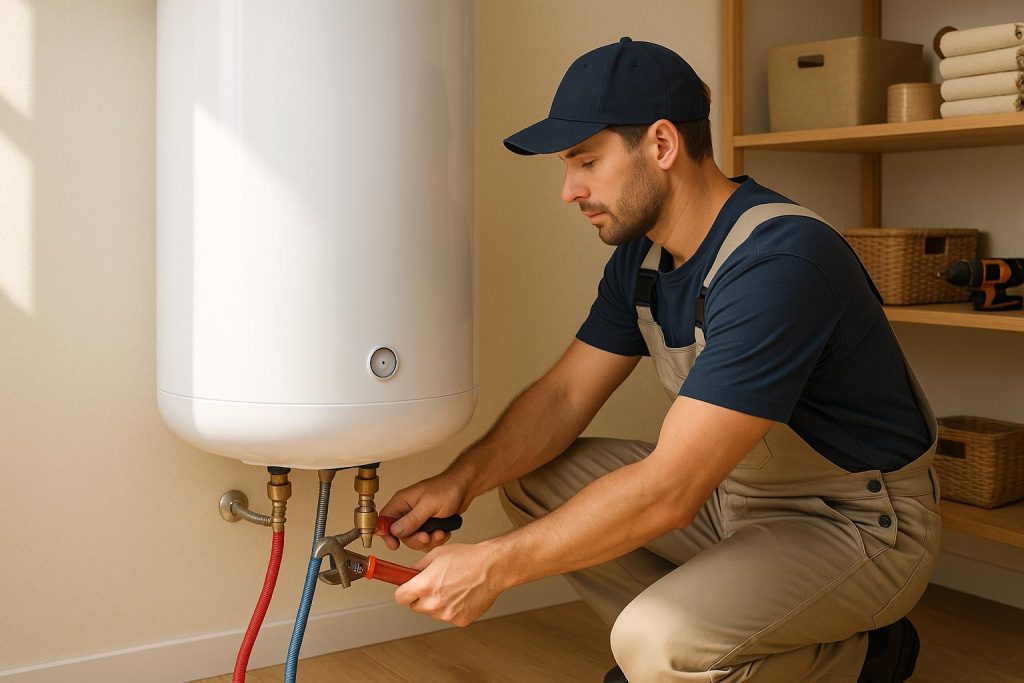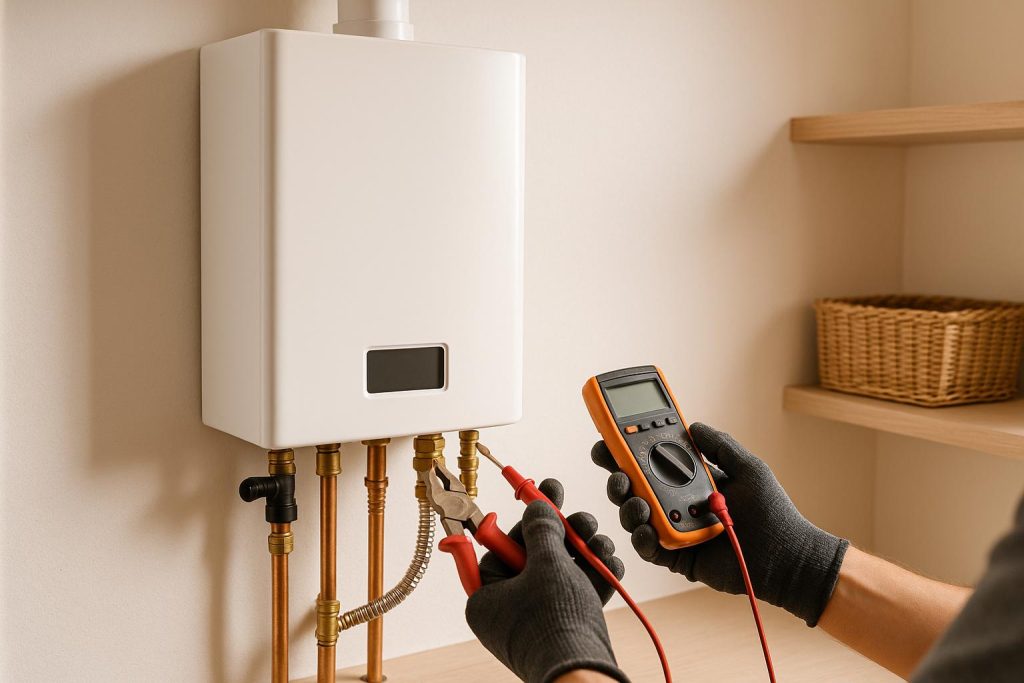
When you experience the issue of upstairs being hot while downstairs remains cold, it’s a common problem in multi-story homes and can be caused by several factors. Understanding the reasons behind this temperature imbalance and knowing how to fix it can help create a more comfortable living environment.
Here are some common causes and solutions:
Causes
- Heat Rises: Hot air naturally rises, which means that the upper levels of your home tend to be warmer than the lower ones.
- Inadequate Insulation: Insufficient insulation in the attic, walls, or roof can allow heat to transfer easily between floors, leading to upstairs warmth and downstairs coldness.
- Poor Ductwork Design: Imbalanced or leaky ductwork can result in uneven distribution of conditioned air, causing temperature disparities.
- Thermostat Location: If the thermostat is placed on the lower level, it may not accurately represent the temperature upstairs, leading to inadequate cooling.
Solutions
- Improve Insulation: Enhance insulation in the attic and walls to minimize heat transfer between floors.
- Seal Leaks: Ensure windows, doors, and ductwork are properly sealed to prevent drafts and maintain consistent temperatures.
- Balanced Ventilation: Ensure that the HVAC system is balanced, and air vents are appropriately adjusted to optimize airflow throughout the house.
- Use Zoning: Consider installing a zoning system that allows you to control the temperature independently on each floor, addressing hot and cold spots effectively.
- Ceiling Fans: Install ceiling fans on the upper level to help distribute warm air downward in the winter and create a cooling breeze in the summer.
- Thermostat Relocation: If possible, move the thermostat to a more central location to better represent the overall temperature in the house.
- HVAC Evaluation: Have a professional HVAC technician inspect the system for issues like ductwork leaks or imbalances, ensuring it’s operating efficiently.
- Window Treatments: Use curtains or blinds to block or allow sunlight as needed to help regulate temperatures on different floors.
How to Fix a House with Hot Upstairs and Cold Downstairs
Let us now look at how to fix a house with uneven temperatures between the upstairs and downstairs in more details.
The following are the different ways to fix the problem of cold downstairs and hot upstairs (balance heat/air between a two-story house):
1. Insulate the Attic and Unblock Soffit Vents

Your upstairs could be hotter than your downstairs because the attic is not properly insulated. That is usually a problem during the summer.
You want to make sure that you keep the cooled air inside the house but not let it leak outside. A badly insulated attic does not only make your upstairs hot, it also makes your air conditioner ineffective since it has to run for long periods of time.
By insulating your attic, you will be ensuring that the conditioned air remains inside the house and that the upstairs is as cool as the downstairs. But how can you tell if the attic is properly insulated or not?
The easiest way to tell if your attic is properly insulated is by looking out for floor joists. If you can see any floor joists then it is a sign that the attic is not properly insulated and that warm/cold air is leaking out through it.
Another reason why your upstairs cold be way warmer than the downstairs is due to blocked soffit vents. Soffit vents allows air into the attic from the outside.
When soffit vents are blocked, fresh and cool air cannot get to the attic, causing the upstairs to heat up. A poorly insulated attic is a major cause of blocked soffit vents. Unblocking soffit vents will have air flowing to the attic and as a result the upstairs will start to cool down.
2. Fix Leaking Air Ducts
A leak in the ductwork could very well be the reason why your upstairs is hotter than your downstairs. Air ducts carry cooled or heated air from the air conditioner or furnace/heat pump to the different areas of your house.
There are supply and return air ducts in an HVAC system. Return air ducts carry air from the house to the air conditioner or furnace while supply air ducts carry cooled or heated air from the AC or furnace to the house and distribute it through the vents.
If cooled air for instance is leaking out of the supply air ducts dedicated to your upstairs, less air-conditioned air will get to your top floor. As a result, you will notice that your upstairs will be hotter than your downstairs.
The simple solution for this problem is to fix the leak. I would recommend that you bring in an HVAC technician to fix this problem. Avid DIYers can do it but most homeowners cannot even find the location of the leak.
Apart from fixing a leaking air duct, an HVAC technician will also inspect the entire ductwork and clean it if need be. Sometimes these ducts can get clogged which can restrict the flow of air to where it is needed.
Technicians can also recommend insulating the ductwork if they deem them not to be properly insulated. When the air ducts are not insulated they result in loss of heat (winter) or heating up of the cooled air (summer).
3. Consider Zoning your HVAC System

As I mentioned, upper floors are naturally warmer than lower floors in a house. That is just how things are, even when heating or cooling are turned off.
One of the best ways to balance the temperatures between your upstairs and downstairs is by zoning your HVAC systems. Zoning is done for different reasons (like when you want to have different temperatures between the different spaces in your house) but it can also be used to achieve temperature balance between house floors.
You can create a dual HVAC zone in your house using your current air conditioner and furnace. You only need to buy a few supplies but the zoned system will use your old HVAC system.
A dual zone HVAC system is a heating and cooling system that uses several thermostats and modulating dampers to create different zones in the house. In this case, your upstairs will be a different zone from the downstairs.
Modulating dampers are like valves (electronic but there are manual ones) which open and close as signaled by the thermostat. They are installed on the ductwork. So, how does this zoned system work?
Since the upstairs and downstairs are at different temperatures but each has its own thermostat, the 2 zones will be heated or cooled differently.
If for instance the upstairs thermostat calls for cooling, all the dampers on the upstairs supply air ducts will open while those on the downstairs supply ducts will shut off. As a result, all the cold air from the air conditioner will be channeled to the upstairs.
In winter when you expect the downstairs to be way colder than upstairs, the downstairs thermostat will call for heating first. The dampers in the upstairs supply ducts will shut off while those on the downstairs ducts will open up, allowing warm air to be supplied downstairs.
4. Install a New and Efficient HVAC System?
How old is your air conditioner? An aged air conditioner or furnace is not as effective as a new one and maybe your problem is that you are using and old and inefficient HVAC system.
Sizing can also be a problem. Is your HVAC system sized properly to sufficiently cool and heat your entire house? Needless to say, if the system is undersized you will without a doubt have temperature imbalance between the different floors of your house.
You may think that bigger is better but actually that is not always the case. For instance, an oversized air conditioner will only cycle for a few minutes then turn off. Short-cycling can cause temperature imbalance as hot air rises to the top levels of the house while the bottom levels stays cool.
It is important to consult an HVAC professional when updating your heating/cooling system. Not only will they help you in properly sizing it but they will advise on all the other things that you need to consider.
If you are thinking about a total overhaul of your HVAC system, I would advise that you consider ductless heating and cooling. Ductless heating and cooling is a type of a zoned system.

Each room in your house will have its separate unit which can be set to its own temperature. Even different rooms upstairs can have different temperatures with a ductless systems.
This is actually one of the main advantage of ductless systems over central air cooling and heating systems. They offer inbuilt zoning.
5. Adjust your System’s Dampers

If your HVAC system has dampers already (usually manual/mechanical dampers), adjusting them may help to balance the temperature between your upstairs and downstairs.
HVAC dampers are a lot more like water shut off valves. You can adjust water valves to control the volume of water passing through.
By adjusting HVAC dampers, you can send more cold air upstairs to balance out with the air downstairs. That means opening the upstairs dampers fully while closing downstairs dampers. Usually the dampers are located very close to the duct trunk (off the furnace).
Another thing you can do especially if you don’t have dampers is to manipulate the air vents. For instance, if the downstairs is too cold (in winter), you can close the upstairs vents and open the downstairs vents.
As you would expect, most of the heated air from the furnace will be forced downstairs which will help to heat it up. In summer, you can also close downstairs vents and open upstairs vents to send cooled air from the AC thereby balancing the heat between upstairs and downstairs.
6. Use Ceiling Fans
An effective way of moving air between your upstairs and downstairs is the utilization of ceiling fans. A spinning ceiling fan can pull up cold air from downstairs while hot upstairs air is pushed downstairs.
For this to work through, the fan have to be installed strategically. There needs to be free flow of air between the downstairs and upstairs.
Note: Setting the fan on your thermostat to instead of AUTO will also help to circulate air throughout the house. the only downside to this problem is that the AC will not reduce indoor humidity as much as it should. It is also expensive to run.
7. Change Air Filter

Your HVAC system uses air filters to clean the air before it is circulated back to the house. The filter is located in the return air duct and should be replaced after every 3 months.
Replacing an air conditioner/furnace filter is easy and does not need to be done by an HVAC technician. You however need to know the size of filter you need, the best quality/type to use and the direction to install it.
Failure to change an air filter causes it to clog thereby restricting the flow of air to the AC/Furnace, which also means limited flow of air in your house. In summer, you will notice that your upstairs is way too hot than you would want it while in the summer your downstairs will be too cold.
Apart from that, the system will be forced to work harder to force air through the filter which cause the energy bills to increase as well. Another sign of a clogged air filter is a frozen air conditioner.
Check out this post to learn about how you can change your air filter.
Wrap Up
Evidently, balancing the temperature between your upstairs and downstairs is a fight against Physics. Hot air will always insist on rising while cold air will sink. However, with the right HVAC system and with the correct installation and settings not forgetting maintenance, you can have your upstairs and downstairs at almost the same temperature.





